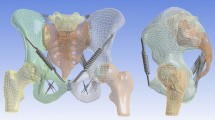Abstract
From a mechanical point of view, the human pelvis can be considered as a stable, complex three link structure. This three-link closed-chain system explains why there is so little motion in the sacroiliac joint. Based on the minimum total potential energy principle, a quasi-static model of the human pelvis with its three joints is developed. In the model, the articular cartilage linings of the joint surfaces are considered as thin layers with a geometric non-linear behaviour. They lie between two rigid curved surfaces that are represented by small three-node elements. Accessory ligaments and capsules are represented by a number of non-linear springs. A primary model is developed based on a female cadaver. According to the primary model, the translation of the sacroiliac joint in the direction of force is about 0·5 mm in the lateral direction, about 1·8 mm in the antero-posterior direction, and about 1·5 mm in the superior or inferior direction, when a load of 1000 N is applied to the sacrum. When a load of 50 N m−1 is applied to the sacrum, the rotation in the load direction is about 1·6° in axial rotation, about 1·0° in flexion or extension and about 1·1° in lateral bending.
Similar content being viewed by others
References
Albee, F. H. (1909): ‘A study of the anatomy and the clinical importance of the sacroiliac joint’,JAMA,53, pp. 1273–1276
Beal, M. C. (1982): ‘The sacroiliac problem: review of anatomy, mechanics, and diagnosis’,J. A.O.A.,10, pp. 678–684
Bernard, T. N., andCassidy, J. D. (1991): ‘Sacroiliac joint syndrome: patho-physiology, diagnosis and management’,inFrymoyer, J. W. (Ed.). ‘The adult spine: Principles and practice’, (Raven Press, New York) pp. 2107–2131
Blankevoort, L., Kuiper, J. H., Huiskes, R., andGrootenboer, H. J. (1991): ‘Articular contact in a three-dimensional model of the knee’,J. Biomech.24 (11), pp. 1019–1031.
Blower, P. W., andGriffin, A. J. (1984): ‘Clinical sacroiliac tests in ankylosing spondylitis and other causes of low back pain: two studies’,Ann. Rheum. Dis.,43, pp. 192–195
Bowen, V., andCassidy, J. D. (1981): ‘Macroscopic and microscopic anatomy of the sacroiliac joint from embryonic life until the eight decade’,Spine,6, pp. 620–628
Brooke, R. (1924): ‘The sacro-iliac joint’,J. Anat.,58, pp. 299–305
Cassidy, J. D. (1993): ‘A study of the gross, microscopic, ultrastructural, and comparative anatomy and development of the articular surfaces of the human sacroiliac joint’, Ph D Dissertation, University of Saskatchewan, Canada
Egund, N., Olsson, T. H., Schmid, H., andSelvik, G. (1978): ‘Movements in the sacroiliac joints demonstrated with roentgen stereophotogrammetry’,Acta Radiolog, Diag.,19, pp. 833–846
Ishimine, T. (1989): ‘Histopathological study of the aging process in the human sacroiliac joint’,J. Jpn. Orthop. Assoc.,63(9), pp. 1074–84
Kissling, R., Brunner, C., andJacob, H.A.C. (1990): ‘Mobility of the sacroiliac joint in vitro’,Z. Orthop.,128 (3), pp. 282–288.
Lavignolle, B., Vital, J. M., Senegas, J.et al. (1983): ‘An approach to the functional anatomy of sacroiliac jointsin vivo’,Anat. Clin.5, pp. 169–174
Maracsco, J. (1986): ‘A variable metric minimizer’,Dr. Dobb's J., March
Marymont, J. V., andLynch, M. H. (1986): ‘Exercise-related stress reaction of the sacroiliac joint’,Am. J. Sport Med.,4, pp. 320–323
Miller, J. A., Schultz, A. B., andAnderson, G. B. (1987): ‘Load displacement behavior of sacroiliac joint’,J. Orthop. Res.,5, pp. 92–101
Mow, V. C., Lai, W. M., andHolmes, M. H. (1982): ‘Advanced theoretical and experimental techniques in cartilage research’inHuiskes, R.et al. (Eds.): ‘Biomechanics: principle and applications’, (Martinus Nijhoff Publishers, The Hague) pp. 47–74
Press, W. H.et al. (1992): ‘Numerical recipes’ (Cambridge) 2nd edn. pp. 408–412
Sturesson, B., Selvik, G., andUden, A. (1988): ‘Movements of the sacroiliac joints: a stereophotogrammetric analysis’,Acta Orthop Scand.,59 (5), pp. 89–89
Sturesson, B.;Selvik, G., andUden, A. (1989): ‘Movement of sacroiliac joint, a roentgen sterophotogrammetric analysis’,Spine,14,(2), pp. 162–165
Takayama, A. (1990): ‘Stress analysis and movement in sacroiliac joint’,J. Jpn. Orthop. Assoc.,57 (5), pp. 476–485
Vleeming, A., Wingarden, J. P. V., Dijkstra, P. F.,et al. (1989) ‘Mobility in the sacroiliac joints in the elderly, a kinematic and radiological study’,Clin. Biomech.,7, pp. 70–176
Walheim, G., Olerud, S., andRibbe, T. (1984): ‘Mobility of the pubic symphysis: measurements by an electromechanical method’,Acta Orthop. Scand.,55, pp. 203–208
Walheim, G., andSelvik, G. (1984): ‘Mobility of the pubic symphysis, in vivo measurements with an electromechanic method and a roentgen stereophotogrammetric method’,Clin. Orthop. Res.191, pp. 129–135
Wismans, J., Veldpaus, F., andJanssen, J. (1980): ‘A three-dimensional mathematical model of the knee-joint’,J. Biomech.,13, pp. 677–685
Zheng, N. (1995): ‘Biomechanics of the human sacroiliac joints’. PhD Dissertation, University of Saskatchewan, Canada
Author information
Authors and Affiliations
Corresponding author
Rights and permissions
About this article
Cite this article
Zheng, N., Watson, L.G. & Yong-Hing, K. Biomechanical modelling of the human sacroiliac joint. Med. Biol. Eng. Comput. 35, 77–82 (1997). https://doi.org/10.1007/BF02534134
Received:
Accepted:
Issue Date:
DOI: https://doi.org/10.1007/BF02534134




